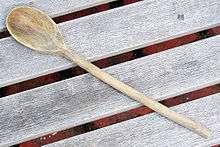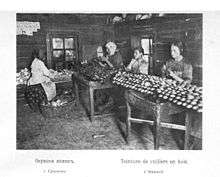Wooden spoon

A wooden spoon is a utensil commonly used in food preparation.
History
The word spoon derives from an ancient word meaning a chip of wood or horn carved from a larger piece.[1] Wooden spoons were easy to carve and thus inexpensive, making them common throughout history.
The Iron Age Celts (C. 250BC) of Britain used them. This is evidenced by an example of a small ladle discovered during archaeological excavations at the Glastonbury Lake Village. Roman period spoons have been recovered from excavations in the City of London. The Anglo Saxons were great workers of wood, as were the Vikings, and both these groups of settlers to the British Isles produced wooden spoons for domestic uses.
Uses
Practicality
Cooking
Today, wooden spoons in western cultures are generally medium to large spoons used for mixing ingredients for cooking or baking. They may be flat or have a small dip in the middle.

Before electric mixers became common, wooden spoons were often used to cream together butter and sugar in recipes such as shortbread or Victoria sponge cake.
They are still used for stirring many different kinds of food and beverages, especially soups and casseroles during preparation, although they tend to absorb strong smells such as onion and garlic. Wooden spoons are generally preferred for cooking because of their versatility. Some cooks prefer to use wooden spoons when preparing risotto because they do not transfer heat as much as metal spoons. Unlike metal spoons, they can also be safely used without scratching non-stick pans. This is useful when making dishes such as scrambled eggs.
Wooden spoons can be treated to protect from cold liquid absorption with coconut or mineral oil. Edible drying oils such as hempseed oil, walnut oil, and flax oil are used to create a more durable finish. For best results, drying oils should be given adequate time to polymerize after application before the spoon is used. Other vegetable oils should be avoided because they will undergo rancidification and leech into food during use. If the wood grain rises up after boiling or washing, a light sanding and application of coconut oil will prevent the spoon from becoming fuzzy and harboring bacteria.
Symbolism
Folk art

Wooden spoons have been made in virtually every nation on earth and (compared to silver or pewter or gold spoons) represent the ordinary artisan and reflect the life of ordinary folk: this is their "folk art".
Each region, sometimes each village, will produce its own very distinct style and type of spoon. Many African examples are carved with wild animals and are aimed at the tourist market; there are others that are ceremonial and contain much symbolism. Distinctive painted spoons have been made in the Khokhloma region of Russia for nearly 200 years, originally for domestic use and in more recent times as tourist objects.
Traditionally, the intricately carved wooden lovespoon has been used as a token of affection in Wales. Each spoon could contain different meaning as shown by the use of various symbols, for instance: a chain would mean a wish to be together forever; a diamond would mean wealth or good fortune; a cross would mean faith; a flower would mean affection; or a dragon for protection. Many sailors carved spoons as they had much free time at sea on their long voyages, they would carve such symbols as anchors or ships into the spoon. Although the Welsh lovespoon has its unique qualities, other styles of lovespoons have been made in Scandinavia and Eastern Europe, notably Romania.
In Botswana the wooden spoon is used as a token to share duties, responsibilities and knowledge, the holder contributes to the work a hand, in whatever small way, like a group contributing to a dish by adding ingredients, mixed by with the spoon.[2]
Sporting culture
In some regions, particularly British-influenced ones of the Commonwealth and the United States, "wooden spoon award" is a booby prize for the team or individual finishing a competition in last position.
Corporal Punishment
The wooden spoon has been used by parents, predominantly mothers, in some cultures as an implement used for corporal punishment, and domestic violence.[3][4][5][6][7][8][9][10][11] Lately it has become a symbol of nostalgia as its actual use has become culturally unacceptable.[12][5][13][3]
See also
References
| Wikimedia Commons has media related to Wooden spoons. |
- ↑ Encyclopædia Britannica, 15th edition, volume IX.
- ↑ Chilisa, Bagele; Ntseane, Gabo (2012). "3. "Resisting Dominant discourses: implications of indigenous, African feminist theory and methods for gender and education research"". In Jessica Ringrose. Rethinking Gendered Regulations and Resistances in Education. Routledge. p. 34. ISBN 9780415693486 – via Google Books.
- 1 2 Gordon, Dan (8 June 2014). "THE FEARSOME BELFAST MAMMY ; Game of Thrones Characters Aren't as Scary as Her!". Belfast Telegraph. Retrieved 23 May 2016 – via Highbeam Research. (subscription required (help)).
- ↑ Mintz, Howard (8 October 2013). "Spanking: San Jose Appeals Court Finds Mom Punishing 12-Year-Old with Wooden Spoon Was Not Child Abuse". Oakland Tribune. Retrieved 23 May 2016 – via Highbeam Research. (subscription required (help)).
- 1 2 Jeffrey, James (12 March 2003). "No Escaping From Gastronomic Gigantism". Moscow Times. Retrieved 23 May 2016 – via Highbeam Research. (subscription required (help)).
My mother discovered muddy footprints on the carpet and reached for her favorite kitchen implement: the Wooden Spoon of Retribution
- ↑ James, Erica (2 January 2008). "...The One Story Erica James Has Never Told...". Daily Mail. Retrieved 23 May 2016 – via Highbeam Research. (subscription required (help)).
- ↑ Insall, Roger; Fowler, Stewart (28 April 2002). "I'd Beat My Two Boys Black and Blue with a Big Wooden Spoon to Teach Them Right & Wrong". The Sunday People. Retrieved 23 May 2016 – via Highbeam Research. (subscription required (help)).
- ↑ Shields, Bob (29 May 1996). "Hair We Go, Hair We Go.; It May Need to Be a Close Shave, but the Scots Can Be a Cut above the Rest". Daily Record. Retrieved 23 May 2016 – via Highbeam Research. (subscription required (help)).
- ↑ Shields, Bob (26 June 2007). "We shouldn't hurry Murray's magic moment.". Daily Record. Retrieved 23 May 2016 – via Highbeam Research. (subscription required (help)).
- ↑ Arnold, Harry (13 January 2001). "HOW MANY OTHER KIDS HAS THIS MONSTER TORTURED TO DEATH?; Police Fear as Little Anna's Killers Get Life". Daily Record. Retrieved 23 May 2016 – via Highbeam Research. (subscription required (help)).
- ↑ Green, Sara Jean (28 March 2012). "Prosecutors: Wife in hatchet slaying abused for years; Husband charged, held on $2M bail; In 2010, she wrote she lived in constant fear". Seattle Times. Archived from the original on 2012. Retrieved 23 May 2016 – via Highbeam Research. (subscription required (help)).
- ↑ 13 Truths Irish People need the World to Understand. The Daily Edge. 21 May 2016 – via facebook.
Don't wave around a wooden spoon when baking, it makes us nervous
- ↑ Bell, Amy (13 October 2015). "There's Nun like the Irish; WHAT MAKES US SO UNIQUE?Book Sends Up Our Culture". Irish Daily Mirror. Retrieved 23 May 2016 – via Highbeam Research. (subscription required (help)).
You fear the wooden spoon.